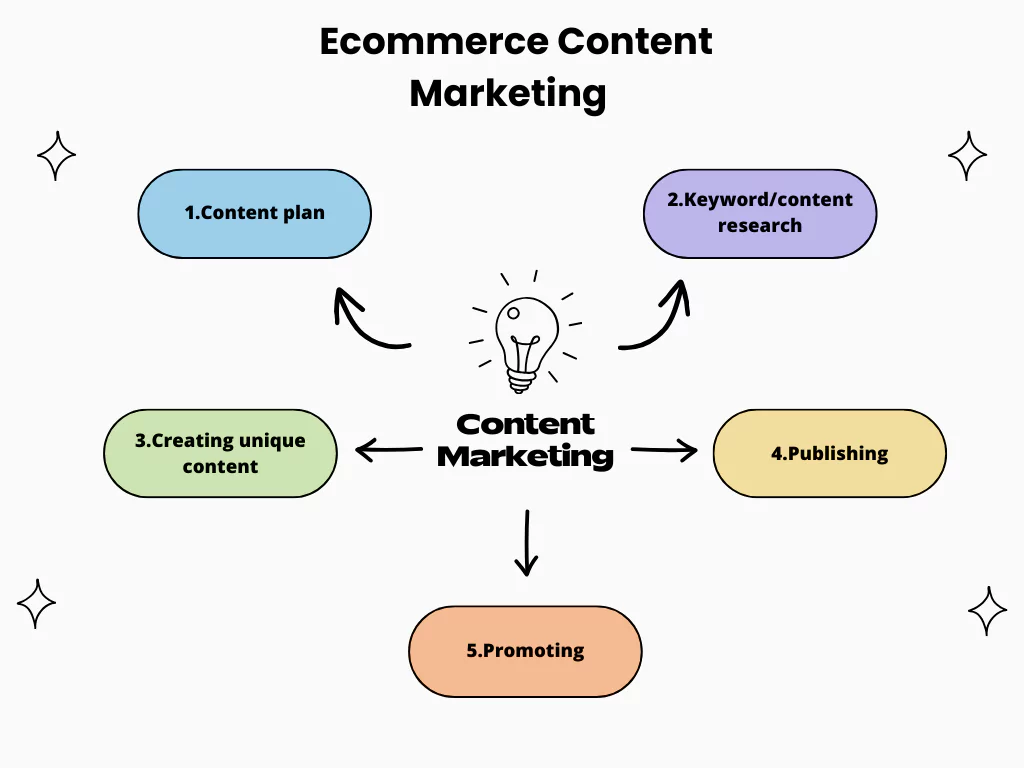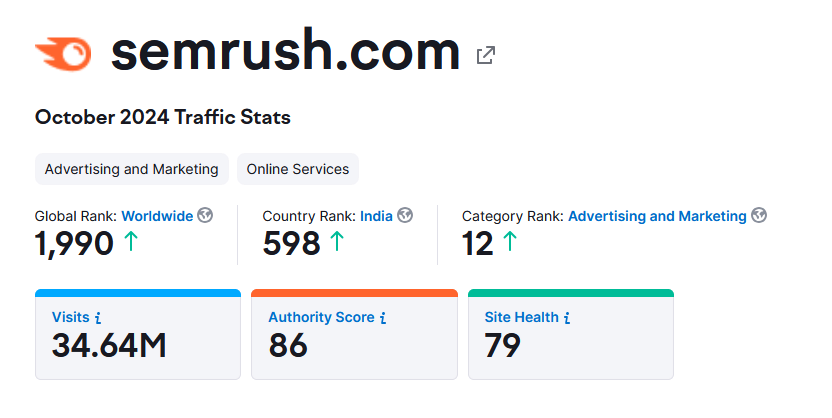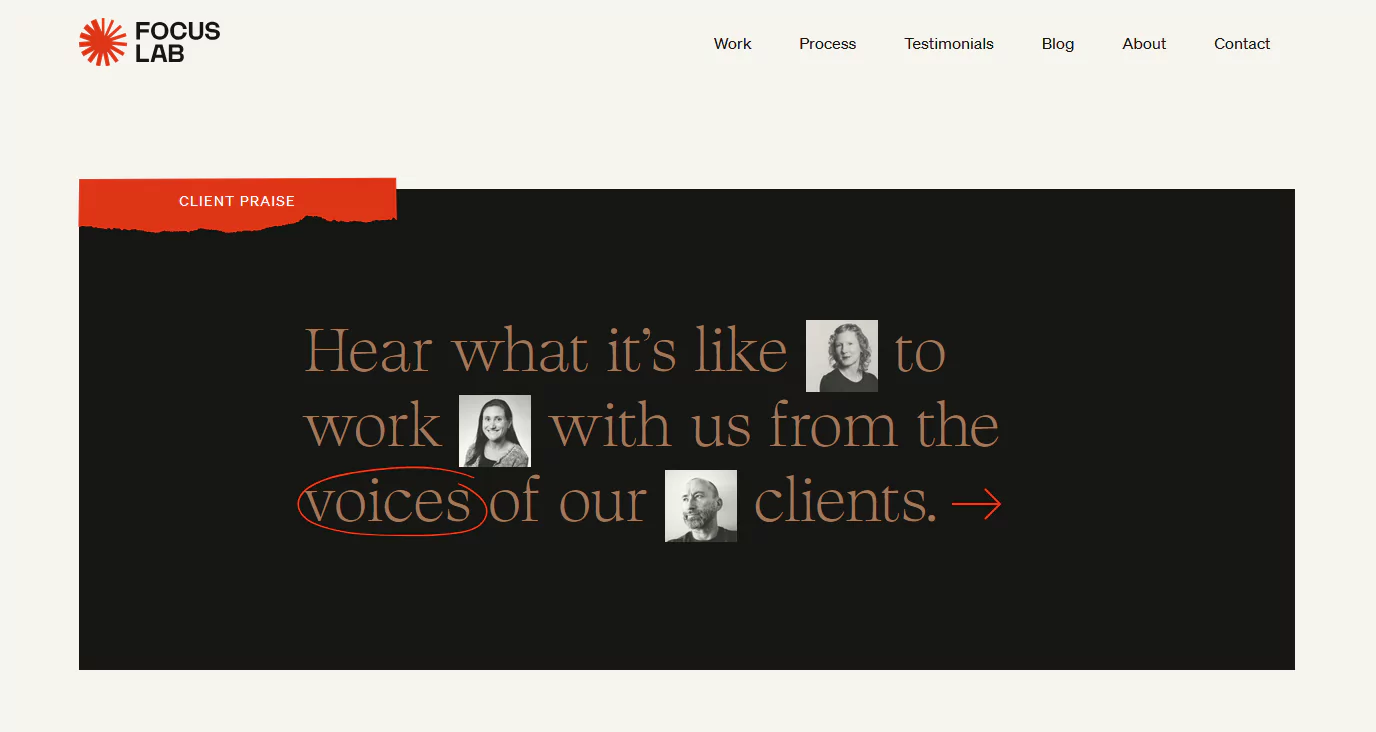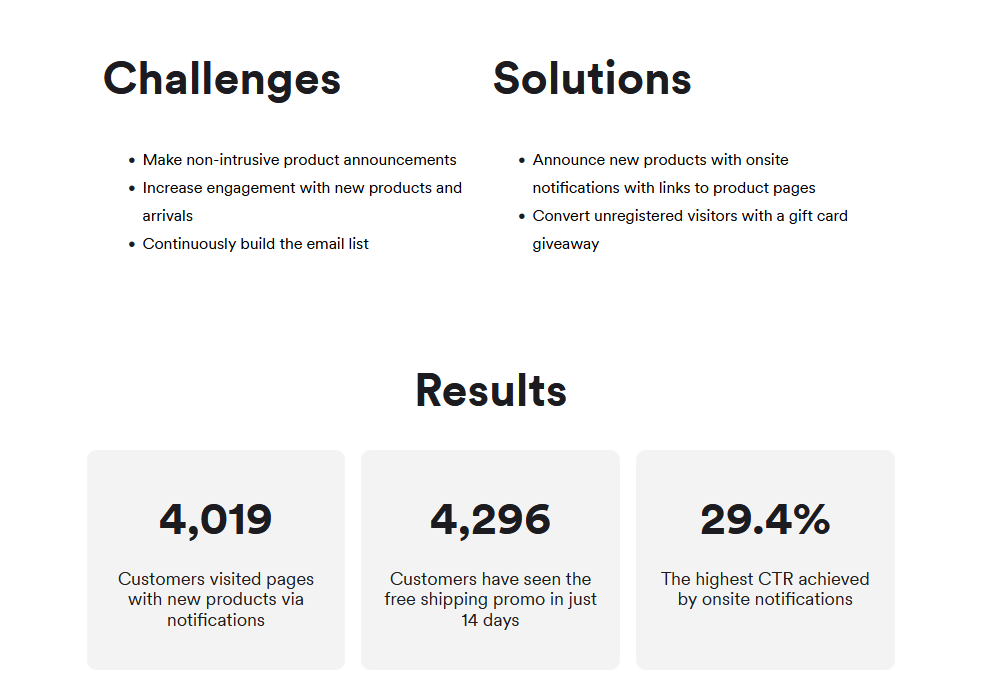Ecommerce Content Marketing: A Complete Guide for 2025

In today’s fiercely competitive ecommerce landscape, standing out is a necessity for both survival and growth. With countless businesses vying for customer attention, you need to establish a distinctive voice that resonates with your target audience. This is where content marketing shines.
In this guide, we will walk you through the fundamentals of ecommerce content marketing, its types and benefits, how to implement it on your ecommerce sites and attract millions of visitors. Let’s wait no more!
What is Content Marketing for Ecommerce?

If you’re wondering what content marketing means, it’s quite simple.
Content marketing for ecommerce is the process of creating and publishing written and visual material on an online platform to generate more leads for your business. You can achieve your desired goals by using some content strategies. These content strategies may include blog posts, infographics, case studies, website pages, and more.
But these are part of a broader content marketing segment. So what exactly is content marketing for ecommerce?
For ecommerce, it is making a content plan, keyword/content research, creating unique content, and publishing and sharing through different channels while following some accurate timing. The main purpose of this is to reach your target audience and increase brand availability, engagement, and loyalty.
In the next section, we will learn about the key benefits of ecommerce content marketing and its types.
6 Key Benefits of Content Marketing for Ecommerce
Content marketing not only helps you enhance your brand awareness but also helps your business in several other ways, including –
Grows Brand Awareness
Multiple research shows that 90% of customers analyze 2 to 7 websites before they make any purchase.
Brand awareness is a valuable asset that comes alive when people actively search for your brand online. This level of recognition is a unique privilege, especially when your brand name starts appearing in search queries, which is a clear indicator that you’ve made a mark in the digital landscape.
However, when you’re new to the market, the chances of direct brand searches are often minimal. In such cases, content that aligns with your target audience’s interests or addresses their needs play an important role.
Builds Trust and Credibility
The first step in building trust and credibility is knowing your brand-trust goals. So, you have to be authentic when writing for your audience.
Authenticity is proven to be the heart of trustworthiness (SocialMediaToday, 2017). Nowadays, buyers want to know how your brand truly is, and authenticity is crucial in reflecting your values and culture. You can achieve this by sharing stories that engage your customers, which helps to build relationships and establish trust.
Another effective approach is to invite your customers to share their own stories. You can showcase these on your social channels to further strengthen your connection with your audience.
Builds Industry Authority
A brand or industry authority is calculated by the number of people who visit your website. That means they consider your brand as an expert or leader where they can easily get their answers. So, which things influence the brand’s authority?
Providing quality content, valuable inputs, and active social engagements can help build an effective brand and finally build credibility and trust. Industry authority is also built by collaborating with industry experts.
This authority makes a good impression on your new and existing customers. It is highly important to nurture your brand to maintain good brand authority.
Increases Website Traffic
When you provide helpful and SEO-driven content for your audience, more potential customers will visit your website and you can engage and convert their interest into sales.
Organic traffic works like growing trees. When you focus on the pain points of your audience and deliver helpful resources, you are likely to –
- Draw more impressions to your website
- Draw more clicks from your target customers
- Rank higher in the SERP
Take a look at Semrush: they’ve achieved an impressive 34.64M visits in just three months, driven by their valuable resources. Similarly, Ahrefs follows a comparable approach. Both brands effectively use content marketing to promote their tools while delivering immense value to their audience.

Improves Customer Relationships
Content marketing is valuable in building relationships between your customers. By creating high-quality content, you can find nearly 6x higher conversion rates compared to those who do not engage in content marketing.

Boosts Conversions
Providing helpful content allows you to address your customers’ pain points and expectations, guiding them seamlessly through the sales journey. This journey begins by solving a problem through engaging methods like video tutorials, product recommendations, or detailed screenshots.
Types of Ecommerce Content Marketing
Ecommerce content marketing is all about driving online sales through strategic and engaging content. There are numerous effective approaches to execute ecommerce content marketing successfully.
Here’s a quick look at some of the best methods –
Blogs
This is regarded as one of the most popular and effective ways of content marketing ecommerce. With a resourceful blog, you can easily promote your related product content with actionable links, and a social share button with detailed information about your product.
You may ask what type of blog you should write for your ecommerce business. In the below sections, we will go into detail about the types of blogs and how they help market your brand. You can cover a wide range of topics including –
- How-to Guide: This type of blog educates readers on how to use your products, solve problems, or complete a task. For example – “How to Style a Home Office for Maximum Productivity”.
- Comparison Articles: Comparison articles help shoppers make informed decisions by comparing similar products or brands. Here is an example of WooCommerce Alternatives: 7 Best WooCommerce Alternatives.
- Listicles: These blog types present products, tips, or ideas in a list format. Blogs like these include titles like – Best Security Plugins for WordPress Websites.
- Product/Platform Spotlights: This type of blog focuses on a single CMS or a product, and showcases its features, benefits, and use cases.
- Customer/Business Stories: Another topic you can cover for your blog is, sharing real-life stories or testimonials. For example, Business Spotlight: Jo and Lucy or How Sarah Boosted her Ecommerce Growth Using Your Products.
- Trend or Seasonal Articles: Use current trends or seasonal events to promote your products like, “Holiday Season Gift Guide: Perfect Solution for Ecommerce Site Owners”
- Expert Roundup: Blogs like these show insights or tips from industry experts related to your products or niche. If you are running an interior shop then it could be like: “Top Interior Designers on Home Office Must-Haves”
Social Media
Content marketing on social media is important for your online presence and your resonance with the customers. Showcasing valuable content on your social media can help resolve their problem.
Research shows that about 73.9% of people use social media for product research. Also, content marketing on social media helps build strong relationships with your audience. It also provides opportunities for paid promotions through platforms like Facebook ads, retargeting campaigns, and image ads.

Podcasts
Podcasts have grown immensely in popularity since their inception in 2004, with over 4 million available today and an expected audience of 504 million listeners by 2025.
This is why they’re an excellent platform to kickstart your content marketing journey.
When done right, podcasts can help you build a loyal, large-scale audience, foster industry connections, and even boost your website’s search engine rankings and overall traffic.
So what are the best ways to include podcasts in your content marketing strategy?
- Create a video and audio version of your product and turn it into a podcast.
- Provide full podcast transcriptions
- Pay attention to your SEO when writing transcripts for audio and video podcasts.
- Distribute and promote your podcast on possible directories as much as possible.
- Promote your podcast show on social media.
Videos
Recently, video marketing has become a trendy marketing strategy with most businesses following this strategy. Research shows that 91% of businesses use this as their marketing hacks.
This strategy can help your business build meaningful relationships with your audience, ultimately boosting conversions and improving overall ROI. Sharing videos on social channels is a powerful way to engage, especially when created in collaboration with top influencers in your industry.
Also, creating a video tutorial series for your audience can provide valuable guidance, and increases their likelihood of converting.
Case Studies
A case study is another trustworthy method to present your business/services/products to your audience. It is the analysis of a particular case of something that has solved a problem in the past. Including the measurable outcomes of the study creates a picture of what success looks like for the buyers. In ecommerce content marketing, it can help you provide –
- Complete examples of your services or products.
- The challenges your clients have faced.
- Solution you have provided.
- Results you have gained.
- Review from your happy clients.
But how do you implement this on your website?
While you can always put your case studies on your homepage, it’s better to have a dedicated page for it. However, here are some common ways you can include case studies on your homepage –
- Customers testimonials
- A CTA to your case study page
Here is an example by Focus Lab, in which they’ve implemented a section with a slider button to show customers testimonials.

If you want to make it more powerful and personalized for your visitors, you can show them examples from their geographical area. Which will be more effective than showing them other country’s case studies.
Another way is to write a blog post about your new case study and post it to your audience on different channels. Here is an example of a Black Ember Case Study shared by Wisepops.

Infographics
An infographic visually represents concepts or data to make information more accessible and engaging. It’s a great marketing tool to communicate effectively with your audience.
For ecommerce, infographics can quickly showcase your products or services, simplify complex processes, and present data in a clear, digestible format. For any other medium, you can use infographics as your marketing. Below is a great example of an infographic by Bradia.

Ebooks
Ebooks are a great way to support your branding and help establish your business as an expert in your niche.
You can become popular by offering ideas and solutions to common user problems within your field of influence. This will help the users be more likely to turn to you rather than your competitor when they need a product or service. There are several ways you can use this marketing strategy in your ecommerce content marketing –
1. You can let your users download your solutions and collect the leads easily. Simply ask them to provide their contact info in exchange for the eBook.
2. Ask them to complete a form and when they complete the form provide the download link to their email. This is a more subtle way to get qualified leads.
3. You can also provide an eBook as an incentive for the people to take action. Such as purchasing a product, signing up for a webinar, or subscribing to your newsletter
Courses
Courses can be a powerful way to grow your brand and build trust. Energy University successfully used this approach by shifting from charging for courses to offering them for free to monetize only the certification process instead.
A similar strategy could work for your ecommerce business. Providing free courses demonstrates your commitment to meeting customer needs while creating value. You can maintain the free course model for as long as it aligns with your goals.
Many creators on platforms like Teachable or Kajabi tie free courses to their ecommerce sites, selling premium products like books, software, or consultation.

Webinars
A well-developed webinar can drive up your content marketing initiatives without significant outside efforts. But to ensure the right outcomes, you need to follow the right approach. Here are some strategies to use to start your webinar for your content marketing –
- Specify Your Webinar Objectives: Webinars are inconsistent but can help you with various results such as leads, onboarding customers, building authority and loyalty, helping promote your product or services, creating new opportunities, awareness, etc.
- Find The Right Presenters: To achieve better results, engage the right educators and influencers to effectively present your topic and ensure higher attendance.
- Make it Interactive: You need to make your webinar more engaging by interacting with the audience. To make it more interactive, select some attendees for an interview, host a Q&A session, and use tools for polls, quizzes, etc.
- Offer Downloadable Content: Offer something at the end of your sessions so attendees remember your event. For example, eBooks, templates, and special coupons for your services or products.
How Does Content Marketing Work for Ecommerce?
Content marketing isn’t just a strategy, it’s an engaging way to communicate and connect with your audience. By following this ecommerce marketing funnel, you can share valuable stories and helpful information, you can attract, educate, and guide potential customers through their buying journey.
Here’s how this process works –
Top of the Funnel (TOFU): Building Awareness
The top of the funnel focuses on building awareness. At this stage, your audience is beginning to recognize a problem but isn’t yet sure how to solve it. Your content plays an important role here, educating them and sparking their interest. The goals for this stage are –
- Capture audience attention.
- Addressing broad challenges and common questions.
- Introduce them to potential solutions.
The content types for TOFU are blog posts, social media updates, infographics, short videos, eBooks, etc. You need to balance educational content with subtle promotion. Use KPIs to measure performance and adjust it based on your audience’s engagement.
Middle of the Funnel (MOFU): Nurturing Considerations
Here, your prospects are aware of their problem and are actively looking for a solution. They are evaluating options including yours, so your goal at this stage is to –
- Build trust and credibility.
- Showcase how your product/services solves their problem.
- Maintain engagement without excessively showing them sales pitches.
Middle of the Funnel content types include Email newsletters, product demos, landing pages, case studies, videos, blog posts, webinars, etc. You can also nurture leads using your social platform to build brand awareness.
Bottom of the Funnel (BOFU): Driving Conversions
At this stage, it’s decision time. Your content should give prospects the confidence to take the final steps and effectively convert. The goals for this stage should be –
- Remove doubts from your visitors.
- Highlight the value and urgency of your product or services.
- Provide clear paths to purchase.
For this stage, your content type should be personalized emails, customer testimonials, pricing pages, comparison tables, and remarketing campaigns. To make it easier for your audience, include a personalized message while writing emails and at the end of the section a strong call-to-action (CTA).
How to Get Started With Ecommerce Content Marketing
Effective content marketing is essential to building trust, driving traffic, and increasing sales. Let’s break down the entire process to help you get started on the right foot –
1. Find Your Target Audience
Before you start curating your content, you need to know your audience. Identify your ideal customers based on factors like age, location, interests, and buying behavior.
You can use tools such as Semrush, and Ahrefs can help you identify their preferences and pain points. Conducting surveys to understand your audience helps make your content more relatable and effective. Speaking directly to the right people builds trust and increases the likelihood that they’ll value and embrace your solution.
2. Build a Content Marketing Plan
A clear plan ensures focused and consistent effort. Aligning it with seasonal trends or product launches improves long-term results.
- Define your content goals (e.g. increase website traffic, boost sales).
- Decide on content formats (blogs, videos, social posts).
- Set a budget for your content promotion.
- Set a schedule for your content publishing.
- Create and distribute your content.
- Finally, analyze and measure your result.
3. Create Engaging Content
Create product content that educates, entertains, or solves problems for your audience. Highlight how your products or services improve their lives with a natural, conversational tone. Use high-quality visuals to stand out, and focus on key ideas. People remember stories, so show how your product fits into their narrative.
4. Promote Your Content
Use multiple channels like social media, email newsletters, and collaborations with influencers to get your content in front of more people. Don’t forget to optimize for SEO to help your content rank higher in search results.
You can tailor your promotions for each platform’s unique audience for better engagement.
5. Measure Your Results
Measure your activity results by tracking content performance using tools like Google Analytics. Monitor key metrics such as website traffic, conversion rates, and audience engagement. Use the insights to identify what works and adjust your strategy accordingly.
Remember that, every piece of data is a step closer to refining your strategy and achieving success.
Wrapping Up
Ecommerce content marketing is a long-term game and you probably won’t see the result immediately from your efforts. However, if you work on this consistently by creating useful content, you’ll likely find profitable outcomes from your marketing channel.
For continuous success, you have to keep updated with the new updates and trends and look for ways to optimize your existing approach.
There’s always room to improve your strategy and get even more benefits out of it. Above all, you need to keep an eye on both your content quality and approaches to rank higher in Google search results.
Frequently Asked Questions (FAQs)
Q. What is ecommerce content marketing?
Ecommerce content marketing involves creating and sharing valuable content like blog posts, videos, and social media updates to attract customers, drive traffic to your site, and boost sales.
Q. What are the 4 P’s of marketing in ecommerce?
The 4 P’s of marketing in ecommerce represent a combination of tools and strategies marketers use to achieve their goals: product, price, place, and promotion.
Q. How do I create content for ecommerce?
Here is a step-by-step guide for creating content for your ecommerce site –
Step 1: First, find your target audience.
Step 2: Then, build a content marketing plan for your ecommerce site.
Step 3: Create engaging content for your audience.
Step 4: When content is ready promote them properly
Step 5: Finally, measure your overall result and adjust it if necessary.
Q. Why content marketing is essential for ecommerce businesses?
There are many reasons why content marketing is essential for ecommerce businesses. Here are the key benefits of using content as marketing for ecommerce –
- Grows Brand Awareness
- Build Trust and Credibility
- Builds Industry Authority
- Increases Website Traffic
- Improves Customer Relationships
- Boost Conversions
Subscribe to Our Newsletter
Get the latest WordPress tutorials, trends, and resources right in your inbox. No Spamming, Unsubscribe Anytime.

Thank you for subscribing to our newsletter!
Table of Content
- What is Content Marketing for Ecommerce?
- 6 Key Benefits of Content Marketing for Ecommerce
- Grows Brand Awareness
- Builds Trust and Credibility
- Builds Industry Authority
- Increases Website Traffic
- Improves Customer Relationships
- Boosts Conversions
- Types of Ecommerce Content Marketing
- Blogs
- Social Media
- Podcasts
- Videos
- Case Studies
- Infographics
- Ebooks
- Courses
- Webinars
- How Does Content Marketing Work for Ecommerce?
- Top of the Funnel (TOFU): Building Awareness
- Middle of the Funnel (MOFU): Nurturing Considerations
- Bottom of the Funnel (BOFU): Driving Conversions
- How to Get Started With Ecommerce Content Marketing
- 1. Find Your Target Audience
- 2. Build a Content Marketing Plan
- 3. Create Engaging Content
- 4. Promote Your Content
- 5. Measure Your Results
- Wrapping Up
- Frequently Asked Questions (FAQs)
- Q. What is ecommerce content marketing?
- Q. What are the 4 P’s of marketing in ecommerce?
- Q. How do I create content for ecommerce?
- Q. Why content marketing is essential for ecommerce businesses?













